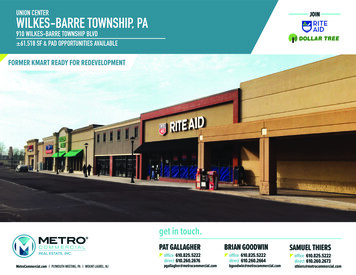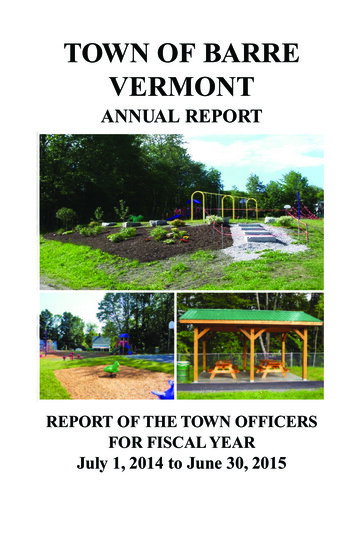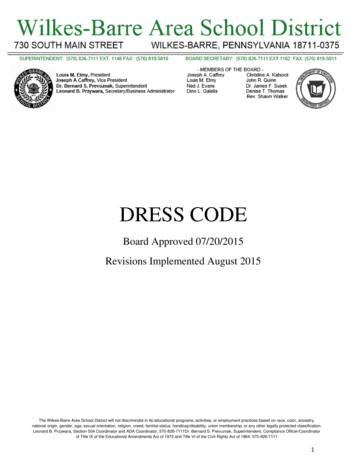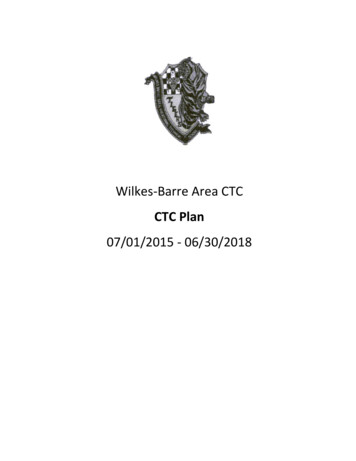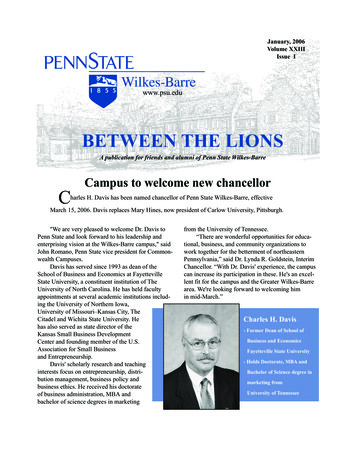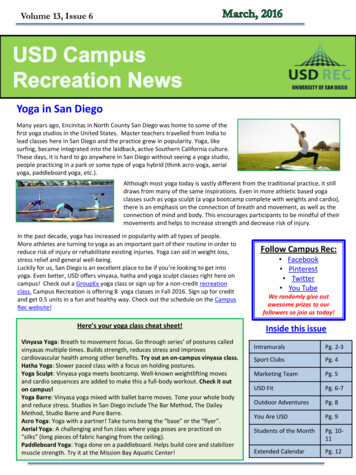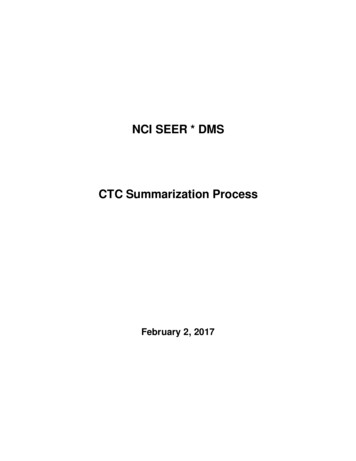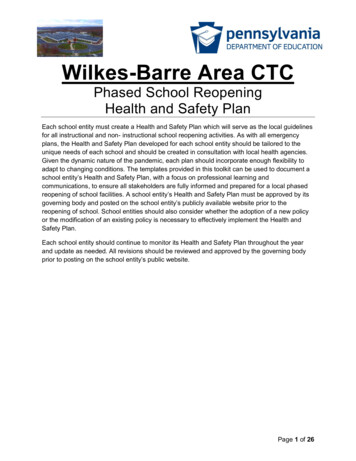
Transcription
Wilkes-Barre Area CTCPhased School ReopeningHealth and Safety PlanEach school entity must create a Health and Safety Plan which will serve as the local guidelinesfor all instructional and non- instructional school reopening activities. As with all emergencyplans, the Health and Safety Plan developed for each school entity should be tailored to theunique needs of each school and should be created in consultation with local health agencies.Given the dynamic nature of the pandemic, each plan should incorporate enough flexibility toadapt to changing conditions. The templates provided in this toolkit can be used to document aschool entity’s Health and Safety Plan, with a focus on professional learning andcommunications, to ensure all stakeholders are fully informed and prepared for a local phasedreopening of school facilities. A school entity’s Health and Safety Plan must be approved by itsgoverning body and posted on the school entity’s publicly available website prior to thereopening of school. School entities should also consider whether the adoption of a new policyor the modification of an existing policy is necessary to effectively implement the Health andSafety Plan.Each school entity should continue to monitor its Health and Safety Plan throughout the yearand update as needed. All revisions should be reviewed and approved by the governing bodyprior to posting on the school entity’s public website.Page 1 of 26
Table of ContentsHealth and Safety Plan . 3Type of Reopening . 4Pandemic Coordinator/Team . 5Key Strategies, Policies, and Procedures . 6Cleaning, Sanitizing, Disinfecting and Ventilation . 8Social Distancing and Other Safety Protocols .10Monitoring Student and Staff Health.14Other Considerations for Students and Staff .16Health and Safety Plan Professional Development .18Health and Safety Plan Communications.20Health and Safety Plan Summary .21Facilities Cleaning, Sanitizing, Disinfecting and Ventilation.21Social Distancing and Other Safety Protocols.22Monitoring Student and Staff Health .23Other Considerations for Students and Staff .25Health and Safety Plan Governing Body Affirmation Statement .26This resource draws on a resource created by the Council of Chief State School Officers(CCSSO) that is based on official guidance from multiple sources to include: the Centers forDisease Control and Prevention, the White House, American Academy of Pediatrics, LearningPolicy Institute, American Enterprise Institute, Rutgers Graduate School of Education, the WorldHealth Organization, the Office of the Prime Minister of Norway as well as the departments ofeducation/health and/or offices of the governor for Idaho, Montana, New York, Texas andWashington, DC.Page 2 of 26
Health and Safety Plan: Wilkes-Barre Area Career and Technical CenterAll decision-makers should be mindful that as long as there are cases of COVID-19 in the community, there are no strategies thatcan completely eliminate transmission risk within a school population. The goal is to keep transmission as low as possible to safelycontinue school activities. All school activities must be informed by Governor Wolf’s Process to Reopen Pennsylvania. Theadministration has categorized reopening into three broad phases: red, yellow, or green. These designations signal how countiesand/or regions may begin easing some restrictions on school, work, congregate settings, and social interactions: The Red Phase: Schools remain closed for in-person instruction and all instruction must be provided via remote learning,whether using digital or non-digital platforms. Provisions for student services such as school meal programs should continue.Large gatherings are prohibited.The Yellow Phase and Green Phase: Schools may provide in-person instruction after developing a written Health and SafetyPlan, to be approved by the local governing body (e.g. board of directors/trustees) and posted on the school entity’s publiclyavailable website.Based on your county’s current designation (i.e., red, yellow, green) and the best interests of your local community, indicate whichtype of reopening your LEA has selected by checking the appropriate box in row three of the table below. Use the remainder of thetemplate to document your LEA’s plan to bring back students and staff, how you will communicate the type of reopening withstakeholders in your community, and the process for continued monitoring of local health data to assess implications for schooloperations and potential adjustments throughout the school year.Depending upon the public health conditions in any county within the Commonwealth, there could be additional actions, orders, orguidance provided by the Pennsylvania Department of Education (PDE) and/or the Pennsylvania Department of Health (DOH)designating the county as being in the red, yellow, or green phase. Some counties may not experience a straight path from a reddesignation, to a yellow, and then a green designation. Instead, cycling back and forth between less restrictive to more restrictivedesignations may occur as public health indicators improve or worsen. This means that your school entity should account forchanging conditions in your local Health and Safety Plan to ensure fluid transition from more to less restrictive conditions in each ofthe phase requirements as needed.Page 3 of 26
Type of ReopeningKey Questions How do you plan to bring students and staff back to physical school buildings, particularly if you still need social distancing inplace?How did you engage stakeholders in the type of re-opening your school entity selected?How will you communicate your plan to your local community?Once you reopen, what will the decision-making process look like to prompt a school closure or other significant modificationto operations?Based on your county’s current designation and local community needs, which type of reopening has your school entityselected? Total reopen for all students and staff (but some students/families opt for distance learning out of safety/healthconcern). Scaffolded reopening: Some students are engaged in in-person learning, while others are distance learning (i.e., somegrade levels in-person, other grade levels remote learning). Blended reopening that balances in-person learning and remote learning for all students (i.e., alternating days orweeks). Total remote learning for all students. (Plan should reflect future action steps to be implemented and conditions thatwould prompt the decision as to when schools will re-open for in-person learning).Anticipated launch date for in-person learning (i.e., start of blended, scaffolded, or total reopening):Page 4 of 26
Pandemic Coordinator/TeamEach school entity is required to identify a pandemic coordinator and/or pandemic team with defined roles and responsibilities forhealth and safety preparedness and response planning during the phased reopening of schools. The pandemic coordinator and teamwill be responsible for facilitating the local planning process, monitoring implementation of your local Health and Safety Plan, andcontinued monitoring of local health data to assess implications for school operations and potential adjustments to the Health andSafety Plan throughout the school year. To ensure a comprehensive plan that reflects the considerations and needs of everystakeholder in the local education community, LEAs are encouraged to establish a pandemic team to support the pandemiccoordinator. Inclusion of a diverse group of stakeholders is critical to the success of planning and implementation. LEAs are highlyencouraged to make extra effort to engage representatives from every stakeholder group (i.e., administrators, teachers, support staff,students, families, community health official or other partners), with a special focus on ensuring that the voices of underrepresentedand historically marginalized stakeholder groups are prioritized. In the table below, identify the individual who will serve as thepandemic coordinator and the stakeholder group they represent in the row marked “Pandemic Coordinator”. For each additionalpandemic team member, enter the individual’s name, stakeholder group they represent, and the specific role they will play inplanning and implementation of your local Health and Safety Plan by entering one of the following under “Pandemic Team Roles andResponsibilities”: Health and Safety Plan Development: Individual will play a role in drafting the enclosed Health and Safety Plan;Pandemic Crisis Response Team: Individual will play a role in within-year decision making regarding response efforts in theevent of a confirmed positive case or exposure among staff and students; orBoth (Plan Development and Response Team): Individual will play a role in drafting the plan and within-year decisionmaking regarding response efforts in the event of confirmed positive case.Individual(s)Stakeholder Group RepresentedPandemic Team Roles and Responsibilities(Options Above)Anthony Guariglia, PhDWBACTC AdministrationPandemic Coordinator, BOTH Development and ResponseFrank MajikesWBACTC Student PopulationBOTH Development and ResponseDeizaRae HeightWBACTC StaffBOTH Development and ResponseWilliam ChristianTechnology / On-Line LearningBOTH Development and ResponseKevin ElmyMaintenanceBOTH Development and ResponsePage 5 of 26
Joe SalvoSanitizing, Disinfection, andVentilationBOTH Development and ResponseJill KingParent PopulationBOTH Development and ResponseJohn KozerskiWBACTC Teachers AssociationBOTH Development and ResponseMegan Bartuska, RNStudent and Faculty HealthBOTH Development and ResponseKaren JonesBusiness/Industry PopulationBOTH Development and ResponseKey Strategies, Policies, and ProceduresOnce your LEA has determined the type of reopening that is best for your local community and established a pandemic coordinatorand/or pandemic team, use the action plan templates on the following pages to create a thorough plan for each of the requirementsoutlined in the Pennsylvania Department of Education’s Preliminary Guidance for Phased Reopening of PreK-12 Schools.For each domain of the Health and Safety Plan, draft a detailed summary describing the key strategies, policies, and proceduresyour LEA will employ to satisfy the requirements of the domain. The domain summary will serve as the public-facing description ofthe efforts your LEA will take to ensure health and safety of every stakeholder in your local education community. Thus, the summaryshould be focused on the key information that staff, students, and families will require to clearly understand your local plan for thephased reopening of schools. You can use the key questions to guide your domain summary.For each requirement within each domain, document the following: Action Steps under Yellow Phase: Identify the discrete action steps required to prepare for and implement the requirementunder the guidelines outlined for counties in yellow. List the discrete action steps for each requirement in sequential order.Action Steps under Green Phase: Identify the specific adjustments the LEA or school will make to the requirement duringthe time period the county is designated as green. If implementation of the requirement will be the same regardless of countydesignation, then type “same as Yellow” in this cell.Lead Individual and Position: List the person(s) responsible for ensuring the action steps are fully planned and the systemis prepared for effective implementation.Materials, Resources, and/or Supports Needed: List any materials, resources, or support required to implement therequirement.Page 6 of 26
Professional Development (PD) Required: In order to implement this requirement effectively, will staff, students, families, orother stakeholders require professional development?In the following tables, an asterisk (*) denotes a mandatory element of the plan. All other requirements are highly encouraged to theextent possible.Page 7 of 26
Cleaning, Sanitizing, Disinfecting and VentilationKey Questions How will you ensure the building is cleaned and ready to safely welcome staff and students?How often will you implement cleaning, sanitation, disinfecting, and ventilation protocols/procedures to maintain staff andstudent safety?What protocols will you put in place to clean and disinfect throughout an individual school day?Which stakeholders will be trained on cleaning, sanitizing, disinfecting, and ventilation protocols? When and how will thetraining be provided? How will preparedness to implement as a result of the training be measured?Summary of Responses to Key Questions: We will ensure the building is cleaned and ready to safely welcome staff and students by training all staff in proper sanitizingprotocols.We will implement cleaning, sanitation, disinfecting, and ventilation protocols/procedures to maintain staff and student safetyon a constant basis, following guidelines for both green and yellow county standards.We have outlined above the procedures to clean and disinfect throughout an individual school day. We will constantly rotateall areas in a yellow phase and daily in a green phase.All appropriate stakeholders will be trained on cleaning, sanitizing, disinfecting, and ventilation protocols. This training willbegin on 9/1/20202 and continue throughout the school year.Page 8 of 26
Requirements* Cleaning,sanitizing,disinfecting, andventilatinglearning spaces,surfaces, and anyother areas usedby students (i.e.,restrooms,drinkingfountains,hallways, andtransportation)Action Stepsunder Yellow PhaseAction Stepsunder Green PhaseLead Individualand PositionAll staff will be trained in cleaning,sanitizing, disinfecting, andventilating their learning spaces atthe 9/1/20 In-Service.All staff will be trained in cleaning,sanitizing, disinfecting, andventilating their learning spaces atthe 9/1/20 In-Service.Anthony Guariglia,PhD – AdministrativeDirectorWater fountains will be closed andwater will be provided.Water fountains will be closed andwater will be provided.General areas such as restrooms,and hallways will be constantlysanitized by custodial staff on arotating basis continuously with nolonger than 15 minutes betweencleaning.General areas such as restrooms,and hallways will be constantlysanitized by custodial staff on arotating basis continuously with nolonger than 2 hours betweencleaning.WBACTC not involved intransportation of students,however, students will sanitizetheir hands before getting on thebus and immediately after exitingthe bus and before / afterbreakfast and lunch.Students will sanitize their handsbefore getting on the bus andimmediately after exiting the busand before / after breakfast andlunch.Masks suggested for students andworn by students who come intoclose contact with others (i.e.Cosmetology)Masks worn by staff.Classrooms and general areas,including SHINE areas, will be“Fogged” each day.Any person (student or staff)exhibiting sings of infection will beKevin Elmy,SuperintendentGroundsJoe Salvo, PlantManagerMaterials, Resources,and or SupportsNeeded SanitizerDisinfectantMasksShieldsHVAC FiltersPD for all staff“Fog” sanitizer fluidAdditionalMicroban “Fog”sanitizer units.PDRequired(Y/N)YClassrooms and general areas,including SHINE areas, will be“Fogged” each week.Masks suggested for students.Masks suggested for staff.Any person (student or staff)exhibiting sings of infection will beimmediately quarantined in thedesignated area and sent home.Page 9 of 26
immediately quarantined in thedesignated area and sent home.Identified students with healthissues will be isolated in the labareas and monitored daily bySchool Nurse.Other cleaning,sanitizing,disinfecting, andventilationpracticesOffice spaces will be constantlysanitized by custodial staff on arotating basis continuously with nolonger than 2 hours betweencleaning.HVAC Filters cleaned on a rotatingbasis.Identified students with healthissues will be routinely monitoredby School Nurse.Office spaces will be sanitized bycustodial staff every day.Kevin Elmy,SuperintendentGroundsHVAC Filters cleaned on a rotatingbasis.Joe Salvo, PlantManager SanitizerDisinfectantMasksShieldsHVAC FiltersPD for all staff“Fog” sanitizer fluidAdditionalMicroban “Fog”sanitizer units.YSocial Distancing and Other Safety ProtocolsKey Questions How will classrooms/learning spaces be organized to mitigate spread?How will you group students with staff to limit the number of individuals who come into contact with each other throughout theschool day?What policies and procedures will govern use of other communal spaces within the school building?How will you utilize outdoor space to help meet social distancing needs?What hygiene routines will be implemented throughout the school day?How will you adjust student transportation to meet social distancing requirements?What visitor and volunteer policies will you implement to mitigate spread?Will any of these social distancing and other safety protocols differ based on age and/or grade ranges?Which stakeholders will be trained on social distancing and other safety protocols? When and how will the training beprovided? How will preparedness to implement as a result of the training be measured?Page 10 of 26
Summary of Responses to Key Questions:RequirementsAction Stepsunder Yellow PhaseAction Stepsunder Green PhaseLead Individual andPositionMaterials, Resources,and or SupportsNeededPDRequired(Y/N)* Classroom/learning spaceoccupancy thatallows for 6 feet ofseparation amongstudents and staffthroughout theday, to themaximum extentfeasibleAll students will be spread outthroughout the lab and theoryareas to the best possible extent.If the number of students exceedthe CDC recommended space, theclass will be split and placed in adesignated “overflow” room, whereinstruction will continue.All students will be spread outthroughout the lab and theoryareas to the best possible extent.Frank Majikes,Principal SanitizerDisinfectantMasksShieldsY* Restricting theuse of cafeteriasand othercongregatesettings, andserving meals inalternate settingssuch asclassroomsStudents will be called by shop forbreakfast and lunch and will eat intheir shop areas.Students will use the cafeteria;however, we will isolate the 3largest shops (Law, Culinary Arts,Cosmetology) to eat in their labareas, which will keep the numberof students below 250 in thecafeteria.Frank Majikes,Principal SanitizerDisinfectantMasksShieldsN* Hygiene practicesfor students andstaff including themanner andfrequency ofhand-washing andother bestpracticesStudents will be taught properpersonal sanitizing proceduresStudents will be taught properpersonal sanitizing proceduresFrank Majikes,PrincipalBi-Lingual Posters displayingsanitizing steps and otherappropriate protocols will be hungthroughout buildings in areaswhere students will sanitize.Megan Bartuska,School Nurse.SanitizerDisinfectantMasksShieldsBi-Lingual PostersYBi-Lingual Posters displayingsanitizing steps and otherappropriate protocols will be hungthroughout buildings in areaswhere students will sanitize. Page 11 of 26
Materials, Resources,and or SupportsNeededPDRequired(Y/N)Megan Bartuska,School Nurse.Bi-Lingual PostersNPandemicCoordinator: AnthonyGuariglia, PhD –AdministrativeDirectorNone requiredNSports not applicable, however,CTSO’s (Career and TechnicalStudent Organizations) generalmeetings will be held and limitedto under 250 people.Frank Majikes,PrincipalNone requiredNStudents materials that are sharedwill be sanitized after each studentuse.Students materials that are sharedwill be sanitized each day.Frank Majikes,Principal Students will stay in designatedProgram of Study Areas.Marketing will operate on adelivery system.Students will be allowedthroughout the building; however,Marketing will operate on adelivery system.Frank Majikes,PrincipalNone requiredAction Stepsunder Yellow PhaseAction Stepsunder Green Phase* Posting signs, inhighly visiblelocations, thatpromote everydayprotectivemeasures, andhow to stop thespread of germsBi-Lingual Posters displayingsanitizing steps and otherappropriate protocols will be hungthroughout buildings and senthome in English/Spanish.Bi-Lingual Posters displayingsanitizing steps and otherappropriate protocols will be hungthroughout buildings and senthome in English/Spanish.* Identifying andrestricting nonessential visitorsand volunteersAll non-essential visitors andvolunteers will be restricted.All non-essential visitors andvolunteers will be limited so noarea has over 250 individuals.i.e. College and Military recruiterswill go shop by shop instead ofcafeteria.i.e. College and Military recruiterswill meet in cafeteria, monitorednot to exceed 250 people at anyone time.* Handling sportingactivities forrecess andphysicaleducation classesconsistent withthe CDCConsiderationsfor Youth SportsSports not applicable, however,CTSO’s (Career and TechnicalStudent Organizations) generalmeetings will be suspended.Limiting the sharingof materials amongstudentsStaggering the useof communalspaces andhallwaysRequirementsLead Individual andPositionSanitizerDisinfectantMasksShieldsYNPage 12 of 26
Action Stepsunder Yellow PhaseRequirementsAction Stepsunder Green PhaseMaterials, Resources,and or SupportsNeededPDRequired(Y/N)Frank Majikes,PrincipalNone requiredNFrank Majikes,PrincipalNone requiredNLead Individual andPositionAdjustingtransportationschedules andpractices to createsocial distancebetween studentsN/AN/AWe will stay open at all times tomeet each sending districtindividual needs.We will stay open at all times tomeet each sending districtindividual needs.Limiting the numberof individuals inclassrooms andother learningspaces, andinteractionsbetween groups ofstudentsAll students will be spread outthroughout the lab and theoryareas to the best possible extent.If the number of students exceedthe CDC recommended space, theclass will be split and placed in adesignated “overflow” room, whereinstruction will continue.All students will be spread outthroughout the lab and theoryareas to the best possible extent.CTSO’s (Career and TechnicalStudent Organizations) generalmeetings will be suspended.CTSO’s (Career and TechnicalStudent Organizations) generalmeetings will be held and limitedto under 250 people.Coordinating withlocal childcareregarding on sitecare, transportationprotocol changesand, when possible,revised hours ofoperation ormodified schoolyear calendarsOur Child Care Center atWBACTC will coordinate and alterhours as needed to best meet theneeds of our PN program andother individuals. We will notcharge for days not in session.Our Child Care Center atWBACTC will coordinate and alterhours as needed to best meet theneeds of our PN program andother individuals. We will notcharge for days not in session.Anthony Guariglia,PhD – AdministrativeDirectorNone requiredNOther socialdistancing andsafety practicesAll individuals wishing to enter thebuilding will be vetted and directedto wait outside in order for us tobest meet their needs.All individuals entering the buildingwill be vetted and isolated as bestas possible.DeizaRae Height,AdministrativeDirector’s SecretaryNone requiredNPage 13 of 26
Monitoring Student and Staff HealthKey Questions How will you monitor students, staff and others who interact with each other to ensure they are healthy and not exhibitingsigns of illness?Where will the monitoring take place?When and how frequently will the monitoring take place?What is the policy for quarantine or isolation if a staff, student, or other member of the school community becomes ill or hasbeen exposed to an individual confirmed positive for COVID-19? What conditions will a staff or student confirmed to haveCOVID-19 need to meet to safely return to school? Which staff will be responsible for making decisions regarding quarantineor isolation requirements of staff or students?When and how will families be notified of confirmed staff or student illness or exposure and resulting changes to the localHealth and Safety Plan?Which stakeholders will be trained on protocols for monitoring student and staff health? When and how will the training beprovided? How will preparedness to implement as a result of the training be measured?Summary of Responses to Key Questions:Requirements* Monitoringstudents and stafffor symptoms andhistory ofexposureAction Stepsunder Yellow PhaseAny person (student or staff)exhibiting signs of infection will beimmediately quarantined in thedesignated area and sent home.Action Stepsunder Green PhaseIdentified students with healthissues will be routinely monitoredby School Nurse.Lead Individualand PositionMegan Bartuska,School NurseMaterials, Resources,and or SupportsNeededPDRequired(Y/N)Thermometer, masks,gloves, ShieldsNPage 14 of 26
RequirementsAction Stepsunder Yellow PhaseAction Stepsunder Green PhaseLead Individualand PositionMaterials, Resources,and or SupportsNeededPDRequired(Y/N)* Isolating orquarantiningstudents, staff, orvisitors if theybecome sick ordemonstrate ahistory ofexposureAny person (student or staff)exhibiting signs of infection will beimmediately quarantined in thedesignated area and sent home.Identified students with healthissues will be routinely monitoredby School Nurse.Megan Bartuska,School NurseThermometer, masks,gloves, ShieldsN* Returning isolatedor quarantinedstaff, students, orvisitors to schoolAny person (student or staff)exhibiting signs of infection will beimmediately sent home for 15days. Work will be provided andstaff will communicate virtually.Any person (student or staff)exhibiting signs of infection will beimmediately sent home for 15days. Work will be provided andstaff will communicate virtually.Anthony Guariglia,PhD – AdministrativeDirectorNone requiredNNotifying staff,families, and thepublic of schoolclosures andwithin-school-yearchanges in safetyprotocolsSchool Messenger and ourwebsite at www.wbactc.org will beutilized to keep families andstakeholders updated on currentchanges and in generalinformation regarding closures andwithin-school-year changes insafety protocols.School Messenger and ourwebsite at www.wbactc.org will beutilized to keep families andstakeholders updated on currentchanges and in generalinformation regarding closures andwithin-school-year changes insafety protocols.William Christian,On-Line ResourcesImplementationYOther monitoringand screeningpracticesAll individuals not necessary to bein the building will be restrictedfrom entering building.All individuals not necessary to bein the building will be isolated asbest as possible in the building orrestricted from entering building.DeizaRae Height,AdministrativeDirector’s SecretaryNone requiredNTechnology / OnLine LearningPage 15 of 26
Other Considerations for Students and StaffKey Questions How will you determine which staff are willing/able to return? How will you accommodate staff who are unable oruncomfortable to return?How will you determine which students are willing/able to return? How will you accommodate students who are unable oruncomfortable to return?What is the local policy/procedure regarding face coverings for staff? What is the policy/procedure for students?What special protocols will you implement to protect students and staff at higher risk for severe illness?How will you address staff who are ill, or who have family members who have become ill?How will you ensure enough substitute teachers are prepared in the event of staff illness?How will the LEA strategically deploy instructional and non-instructional staff to ensure all students have access to qualitylearning opportunities, as well as supports for social emotional wellness at school and at home?Summary of Responses to Key Questions:RequirementsAction Stepsunder Yellow PhaseAction Stepsunder Green PhaseLead Individualand PositionMaterials, Resources,and or SupportsNeededPDRequired(Y/N)* Protectingstudents and staffat higher risk forsevere illnessAny person at high risk will bemonitored daily by the SchoolNurse for signs of infection. Theindividual may be sent home byPrincipal or AdministrativeDirector.Any person at high risk will bemonitored daily by the SchoolNurse for signs of infection. Theindividual may be sent home byPrincipal or AdministrativeDirector.Anthony Guariglia,PhD – AdministrativeDirectorThermometer, masks,gloves, ShieldsN* Use of facecoverings (masksor face shields) byall staffAll staff will wear masks (Shieldswhen appropriate.) Students willbe encouraged to wear masks.Masks (Shields when appropriate)will be worn when situations lenditself as outlined by the CDC,PDE, and DOH.Anthony Guariglia,PhD – AdministrativeDirectorMasks, gloves, ShieldsYPage 16 of 26
RequirementsAction Stepsunder Yellow PhaseAction Stepsunder Green PhaseLead Individualand PositionMaterials,
Health and Safety Plan: Wilkes-Barre Area Career and Technical Center All decision-makers should be mindful that as long as there are cases of COVID-19 in the community, there are no strategies that can completely eliminate transmission risk within a school population. The goal is to keep transmission as low as possible tosafely
